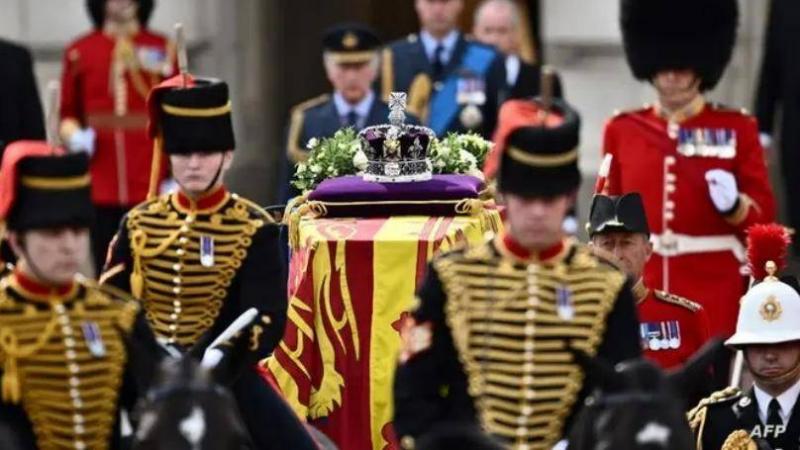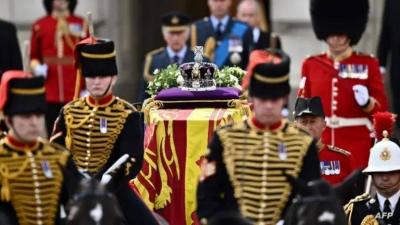The official funeral for the late Queen of Britain, Elizabeth II, took place on Monday amidst great pomp, with several rituals carried out meticulously, attended by prominent world leaders to express their condolences and bid farewell to a queen who reigned for seven decades. Earlier, King Charles, along with his sons Princes William and Harry and senior members of the royal family, participated in a majestic procession behind the queen's coffin amid silence that enveloped the streets of London, following the conclusion of the official funeral held at Westminster Abbey.
The coffin, draped in the flag, was transferred in the first official funeral in the country since 1965, when Winston Churchill's funeral was conducted. Tens of thousands lined the streets to watch the queen's coffin being transported from the historic Westminster Hall, where it lay in state for several days, to the nearby Westminster Abbey. Silence also filled Hyde Park nearby, as thousands who had waited and chatted for hours fell silent when the queen's coffin appeared on screens set up in the park.
Inside the church, before the coffin's final journey, the customary hymns, sung at every official funeral since the early 18th century, began. Among those following the coffin was Prince George, the 9-year-old son of Prince William and grandson of the queen. About two thousand people attended the ceremony, including around 500 heads of states and governments, foreign royal family members, and distinguished figures, including U.S. President Joe Biden and leaders from France, Canada, Australia, China, and Pakistan.
Biden mourned the queen, who passed away at the age of 96 after the longest reign among British monarchs, enjoying near-universal respect for her service to her country. He stated, "You were lucky to have her for 70 years... and so were we all." Amid the crowds that gathered from across Britain and beyond, some climbed streetlights and stood on barriers to catch a glimpse of the royal procession.
Elizabeth passed away on September 8 at Balmoral Castle, her summer residence in Scotland. Her health had been deteriorating, and the queen had missed months of public life after fulfilling hundreds of official engagements following her 90th birthday. She appeared just two days before her death, looking frail but smiling when she appointed Liz Truss as her fifteenth and final prime minister. Prince William told mourners, "We all thought she was invincible."
Elizabeth became the 40th queen on the British throne in 1952, a lineage dating back to 1066. When she succeeded her father King George VI, Churchill was the first prime minister of her reign.
The funeral concluded with two minutes of silence observed by the church and the nation. Following that, the coffin was moved again through central London, passing the queen's official residence, Buckingham Palace, to the Wellington Arch at Hyde Park Corner, with King Charles and the royal family following on foot for a distance of 2.4 kilometers. From there, it was transported to Windsor Castle in west London, where a service was held at St. George's Chapel. The coffin was later lowered into the royal vault, and in a private family ceremony later that evening, the coffins of Elizabeth and her husband for over 70 years, Prince Philip, who passed away last year at 99, were buried together in the George VI memorial chapel, where her parents and sister are interred.




